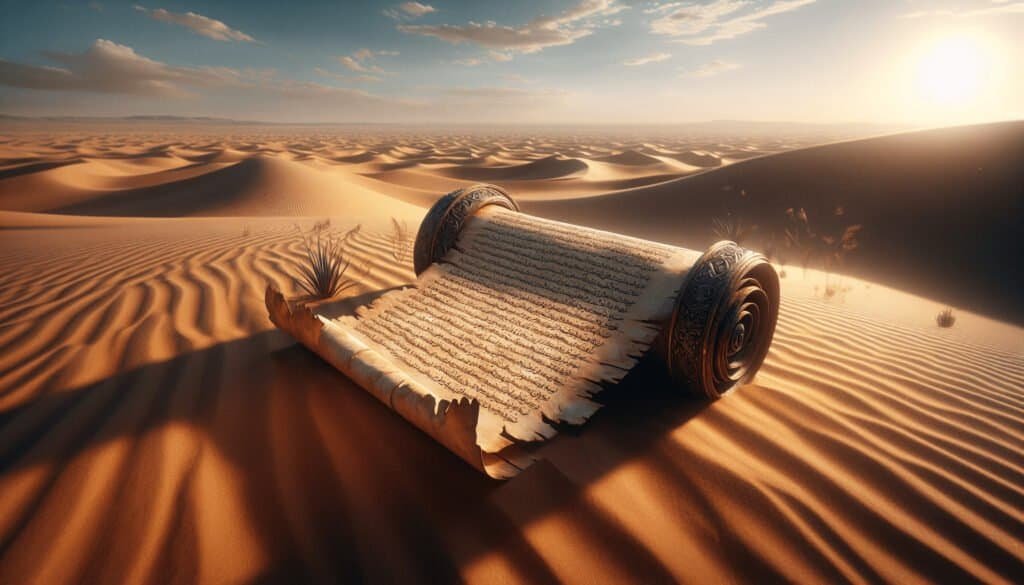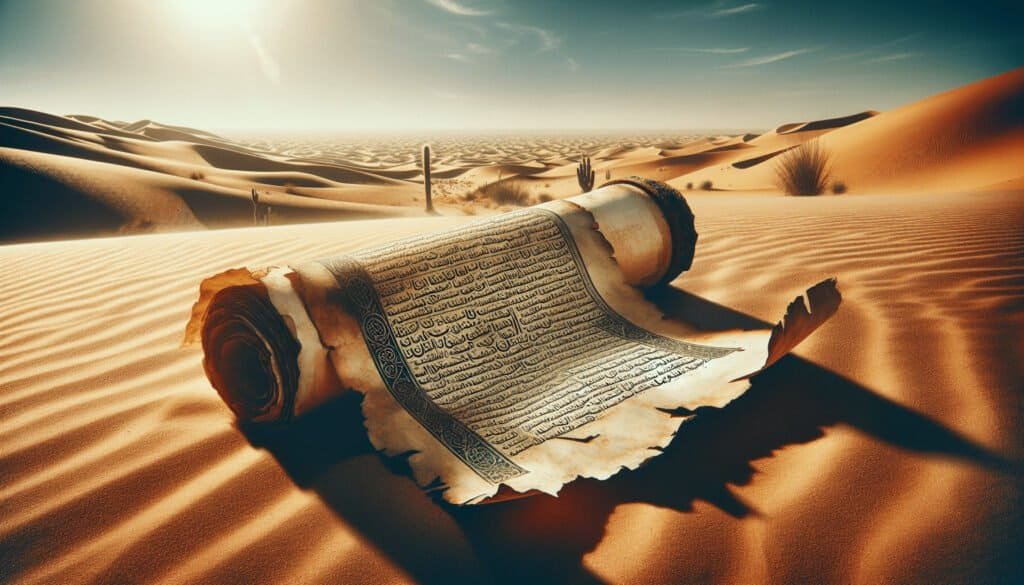What if you found a collection of poems that held the whispers of ancient faith mingled with the starkness of a desert landscape?

The Surreal Terrain of Desert Poetry
The desert isn’t just a barren wasteland; it’s a canvas for human experience, and poetry emanates from this landscape that embodies both isolation and revelation. It strikes you how the untouched sands can be the backdrop for some of the most profound thoughts, struggles, and tales of resilience.
This type of poetry serves as an archive relic – a fusion between faith and the gritty reality of existence. Just like ancient texts, these poems reveal the heart of spiritual quests that resonate deeply even today.
Why Poetry in the Desert?
When you think of the desert, you might picture arid landscapes, endless skies, and a sense of desolation. Surprisingly, within this barrenness lies a profound spirit that fuels creativity. Here’s why poetry thrives in such settings:
Isolation Breeds Reflection: The solitude of the desert invites introspection. When stripped away from the hustle of daily life, you’re better equipped to face your innermost thoughts.
Nature as Muse: The stark beauty of the desert inspires imagery and emotion in ways that perhaps more temperate landscapes do not. Each dune, each mirage, can represent profound truths about existence.
A Biblical Context: Many spiritual figures in history found themselves wandering the deserts, seeking connection with the divine. Their struggles and triumphs continue to echo in literary forms.
Historical Context of Desert Poetry
Desert poetry doesn’t just float in the ether; it springs from centuries of spiritual and cultural history. Think of the figures like John the Baptist, wandering the wilderness, or the Jews in Exodus facing trials and tribulations. Each story contributes layers to the literary tapestry.
The Dead Sea Scrolls
One may easily argue that some of the most significant archaeological findings related to faith can be found in the Dead Sea Scrolls. Unearthed in the late 1940s, these texts date back to the 3rd century BCE and showcase a plethora of religious writings, including:
| Text Type | Content | Significance |
|---|---|---|
| Biblical Texts | Early versions of biblical manuscripts | Provides insights into the development of Biblical texts. |
| Apocryphal Writings | Texts not included in the canonical Bible | Reveals the diverse beliefs present during the time. |
| Sectarian Writings | Writings of the Essenes, a monastic community | Information on early Jewish thought and practice. |
The Ark of the Covenant
Take a moment to ponder the Ark of the Covenant, a sacred chest which, according to biblical tradition, housed the tablets inscribed with the Ten Commandments. The stories surrounding it are steeped in mystery and faith, inspiring countless poets and artists alike.
What really stirs your imagination is the imagery of the Ark, often seen as a symbol of God’s presence, intertwining the spiritual and tangible worlds. The quest for the Ark echoes the human desire for connection with something greater and can often serve as a powerful motif in both ancient and modern poetry.

Themes in Desert Poetry
When you start to peel back the layers of emotion and imagery in desert poetry, it’s clear that certain themes consistently emerge. Each theme revisits the connecting threads of faith and reality, making them applicable in various discussions today.
Faith and Doubt
Desert landscapes have a tendency to create a duality within you: the simultaneous yearning for faith and the grappling with doubt. Many poets frame their verses around this push and pull, exploring the tension between believing in the unseen and questioning one’s path.
- Example Poem: Look at how a poet describes the vast emptiness as both a comforting embrace and a haunting absence, emphasizing this connection to spiritual questioning.
Survival and Resilience
In the harshness of the desert, survival becomes a metaphor. The ability to endure challenges can symbolize profound spiritual journeying.
- Imagery: Writers often describe the beauty of a blooming cactus as a beacon of hope against seemingly impossible odds. It’s a powerful reminder that even in the driest places, life finds a way to thrive.
Isolation Leading to Enlightenment
Often, poetic musings on isolation reveal how solitude can lead to moments of enlightenment. In the desert, away from societal distractions, your thoughts crystallize, and insights emerge.
- Symbolism: The vastness of the skies at night can serve as a metaphor for spiritual awakening—the infinity of the universe inviting you to ponder existence in a new light.
Modern Perspectives on Desert Poetry
Turning your gaze to contemporary poetry, consider how modern writers embody the essence of ancient desert poetry yet reinvent it for your current context.
Cultural Connections
Current desert poetry often bridges cultural gaps, drawing from various traditions and inviting readers of diverse backgrounds to connect. This makes the relevance of these works timeless.
- Interwoven Themes: Poets today may mesh personal experiences of loss and longing with cultural histories, often referencing the climates of belief that shape their realities.
The Historical Lens
As you read modern poetry, note how the historical context is still very much alive. Contemporary poets often revisit biblical themes, reinterpreting them through modern-day issues such as displacement, identity, and faith.
- Evolution of Language: Language in modern poetry reflects current societal norms and movements, stretching the biblical narratives in ways that stay relevant to today’s audience.
Notable Poets and Their Voice
It’s curious who emerges as voices from the desert landscape, giving life to the pages of history. A few poets stand out, shaping the dialogue around desert poetry, faith, and reality.
Robert Bly
Bly, an American poet, has penned various poems that delve into themes of existentialism and emotional candidness. His unique ability to approach spirituality through the lens of personal experience resonates deeply with readers seeking connection.
Zora Neale Hurston
While primarily celebrated for her prose, Hurston’s poignant poetry speaks volumes regarding identity and cultural heritage. Her works reflect desert-like struggles against societal barriers, echoing resilience despite life’s harshness.
Nizar Qabbani
This Syrian poet encapsulates the desert’s romantic undertones and complex histories. His writings traverse love, loss, and longing, blending cultural and historical narratives that leave readers pondering the depths of human experience.
The Role of Archeology in Understanding Desert Poetry
Archeological discoveries, much like poetry, often bridge the realms of the past and the present. The remnants of ancient civilizations not only validate historical narratives but also enhance the understanding of literary expressions.
Scriptural Discoveries
Each archaeological finding can add depth to your understanding of desert poetry. The tangible evidence of spiritual life uncovered by archaeologists reinforces the very stories poets write about.
- Example: Discovering ancient synagogues can provide insights into the religious practices of historical figures, allowing you to glean spiritual contexts that inform the poetry of the time.
Cultural Artifacts
Artifacts such as pottery, inscriptions, and tools offer glimpses into the lives of people who once thrived in these arid regions. Each piece contributes a thread to the tapestry of humanity, underscoring a shared heritage that transcends time and space.
Conclusion
Desert poetry stands as a testament to humanity’s relentless quest for meaning, wrapped within the vastness of arid landscapes. It binds faith and reality, evoking images that linger long after you’ve read the last line.
By examining the intricate relationship between historical context, archaeological findings, and lived experience, it’s easy to see how these poems serve as an archive relic, not just artifacts of the past but living dialogues that continue to shape your understanding of faith, existence, and artistry in the present.
As you consider your own spiritual journey, allow the whispers of these ancient verses to resonate within you, serving as reminders of the fluid connection between your faith and the ever-present realities of life. It’s a journey worth taking – within the pages of poetry and the grains of sand that tell ancient tales.


